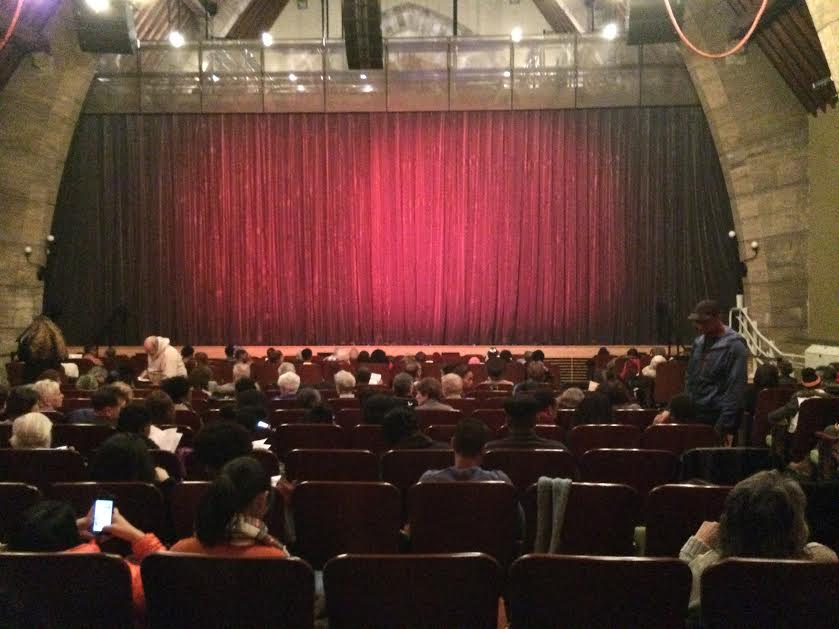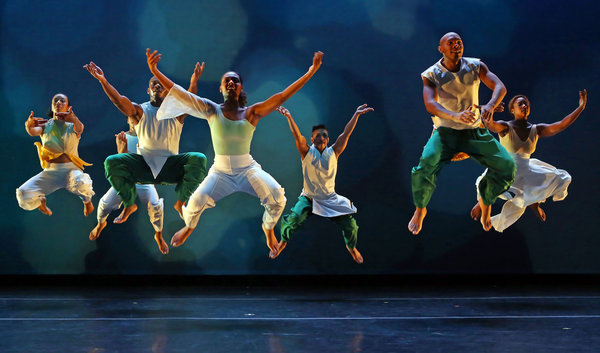The Ronald K. Brown/Evidence Dance Company came to Bryn Mawr College as part of the Bryn Mawr Performing Art Series on Friday February 26 to perform excerpts from four different pieces: Torch (2013). Lessons: March (excerpt) (1995), The Subtle One (2014), and Grace (1999/2004).
I always attend every dance related Performing Arts Series event because I am a dancer myself and love watching as well, but this time I was also there to take notes on how the technical aspects of the show enhanced the performance for my Fundamentals of Technical Theater class taught by Justin McDaniel. I have been looking forward to this dance performance ever since the Performing Arts Series schedule was released in August. I knew this show was going to be a good one after attending the masterclass last Thursday where Ronald K. Brown taught us an excerpt from Torch.
Below are my notes:
Torch (2013)
Ronald K. Brown had told us during the masterclass that this piece was dedicated to his friend Beth who attended many of his dance classes while battling cancer. This was the reason for the woman falling onto the other dancers in a green top light in the beginning of the piece to symbolize death. Throughout the piece, dancers constantly pointed up toward Beth in Heaven as if she were a torch in the sky. This was not a sad piece per se, but a commemorative piece that celebrated her life. The music and lighting choices agreed with this lively tone. The blue-green-purple lighting complimented costume colors of white and green. The purple lighting showed dimension when dancers’ costumes flowed. Lights faded on solo dancers, as well as when the music changed. An impactful transition was when the lights dimmed on the solo dancer, the music changed for the third time, and then the background black curtains opened up to a background projection of pops of color in (also blue-green-yellow) which complimented the jumps and beats of the music.
Lessons: March (excerpt) (1995)
This was a very serious piece set to a speech by Dr. Martin Luther King Jr. about the value of a man. Costuming, movement, and the technical elements mirrored this seriousness. Two male dancers performed a duet in matching black jumpsuits under side wing yellow-orange lights against a black curtain background. These simple stylistic choices put the focus on the message against racism. Here, the role of technical elements was to not detract from the powerful message. The synchronized dance movement, to me, embodied companionship through perseverance and care.
The Subtle One (2014)
The Subtle One‘s use of blue-pink-purple lighting with added green and red at times perhaps suited the medium tempo piano and bass-heavy “cool” jazz music. The plain black background also agreed with the more laid back jazz. I noticed red overhead lighting was added when the music became more chaotic. At one point, the lights faded and dancers exited the stage, falsely cuing to the audience that the piece was over, but it was not. The dancers reentered and the music changed. I think this action of coming and going symbolized the quote provided in the program notes,
“…So Subtle Are The Wings of Angels
That you may not realize they’ve come
and gone, except
That innerly remains a glowing
Which seems just as good as knowing”
— poem excerpt by Alan Harris
Grace (1999/2004)
Unlike the other pieces performed that night, this piece started with the stage lights already on. As the curtains reeled back, we saw a solo dancer dressed in white standing at the center of the stage in front of the background black curtains parted halfway with a blue lit background. According to the program notes, she is a Goddess on a journey to Earth “to spread grace among humans, ultimately welcoming them to heaven.” Slow gospel music played during this first section. Then the background color changed to red as the music changed to disco and additional dancers entered with red and white costumes. They danced together with the goddess. I think the use of blue contrasting with the red symbolized Heaven and Earth respectively. The background light changed back to blue when the music change to saxophone jazzy music. Then purple lights were added before returning back to red. I think purple, which literally is the mixing of blue and red, symbolized the mixing of Heaven and Earth. The piece ended with the background blue and the goddess alone on the stage again with the gospel music, perhaps showing a successful transfer of grace to the Earthlings and a return to Heaven. Now that the Earthlings had been exposed to the grace, they are welcome to Heaven in the future.
Overall
I finally understand why dance incorporates a lot of side wing lighting at plan angles with the shins, body, and head. Dance performance is about highlighting the movements in the body, and sidelighting does a good job of displaying the dancers’ muscles. Overhead and backlighting are also used to create shadow, mood, and setting. This set mostly used the ETC source instruments for the overhead and sidelighting. I am not sure which lighting instrument was used to illuminate the background. I also thought it was visually interesting to use the center curtains as both an entrance and a light focus. The technical elements of light, sound, and materials mixed with the swift and precise dance movements enhanced the overall impact of this performance.
Fun fact: I sat next to former Bryn Mawr President Mary McPherson! I asked her what has changed the most since she left, and she said the faculty turnover. She lives nearby and still attends many events on the campus as well as walks her dog on the grounds.


You could certainly see your enthusiasm in the article you write.
The sector hopes for more passionate writers such as you
who are not afraid to mention how they believe.
At all times go after your heart.